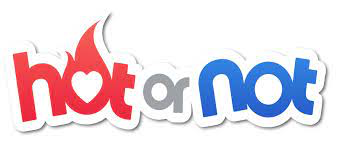Twenty-four years ago, in October 2000, a new relationship website launched called “Hot or Not.” The premise of the site was for people to submit photos of themselves (or others) to have users of the site rate them on a scale of 1 to 10 on their attractiveness.
Within a month of launching, the site reached around two million page views per day.
Mark Zuckerberg’s original idea was to do something similar with a site he created called FashMash, which became TheFacebook.com in 2004 (now just Facebook.com). Likewise, the founders of YouTube said they originally set out to create a video version of “hot or not” before developing a more inclusive site.
HOT or NOT
It was based on this site that Fred Jacobs presented, the things he did and saw at this year’s Consumer Electronics Show in Las Vegas, aka CES 2024, as being “Hot or Not.”
During the webinar, I asked the smarmy question “Is AM Radio HOT?” in the chat box. (No, I didn’t get an answer.)
However, the bigger question really is, “Is RADIO Hot or Not?”
The answer from everything I’m reading is “Not,” at least in the way things are going.
When it came to radio audience ratings, I never concerned myself with individual ratings, but preferred to study audience trends. Here’s the latest trend lines for both broadcast radio and digital streaming:
Not A Viable Business Anymore
In Canada this month, the chief legal and regulatory officer of Bell Media grabbed the headlines worldwide, when he explained the reason Bell was selling off 45 of its radio broadcast properties, was they were “not a viable business anymore.”
“One man’s trash is another man’s radio stations.”
-Fred Jacobs
So, what do you think the buyers of these radio stations must have thought, after the seller tells the world they think the radio stations they just sold are not a viable business?
Surprise, they are very positive about the radio business. Take a moment to listen to this very positive view from the CEO of My Broadcasting Corporation, one of the seven local broadcast companies that purchased radio stations from Bell. You can here that CBC interview here: https://www.cbc.ca/listen/live-radio/1-100-ottawa-morning/clip/16041778-local-bell-media-radio-stations-owner
The State of Media 2024
Harker Bos Group https://harkerbos.com/ released new research on the state of media today and here are some of the key takeaways.
What are radio listeners looking to hear?
- 54% highlight the importance of local coverage
- 67% sound quality
- 54% station availability
- 53% ease of use
When the researchers compared broadcast radio to digital streaming of music, they found that usage of broadcast by younger audiences was losing out to streaming services. Those that are frequent users of streaming music tend to access it via smartphones, computers, smart speakers and tablets preferring on-demand music services with personalized playlists and recommendations. Streaming also provides users global access that is not bound by geographical limitations.
Is The Media Prepared For An Extinction-Level Event?
That headline in the New Yorker caught my attention! The author, Claire Malone, cites “ads are scarce, search and social traffic is dying, and readers are burned out, [which means] the future will require fundamentally rethinking the press’s relationship to its audience.”
The way to become a millionaire in radio,
is to start with a billion dollars.
That’s not something new, that witticism has been around since the end of the 20th Century. I was reminded of it when Claire shared the words of a late-career writer’s advice to the newbies: “You want to make it in journalism, marry rich.”
Last year, 2,681 people were laid off in broadcast, print and digital news media.
In February of this year, after the record-setting viewership to the CBS broadcast of Super Bowl 58, that very network announced it would be cutting 800 jobs.
Significant job cuts have taken place at:
- NBC News
- Vox Media
- Vice News
- Business Insider
- Spotify
- theSkimm
- FiveThirtyEight
- The Athletic
- The New Yorker
- Sports Illustrated
And some other media outlets closed down:
- BuzzFeed
- Gawker
- Pitchfork
- The Messenger (this endeavor lasted less than a year)
“Publishers, brace yourselves – it’s going to be a wild ride.
I see a potential extinction-level event in the future.”
-Matthew Goldstein, media consultant
I share these stories with you, not to depress you, but for you to better understand what’s going on, and that it’s not just a radio problem, but a media problem.
As Netflix, Amazon Prime Video and others add advertising to formerly ad-free streaming channels, where will those ad dollars come from; radio, TV, cable, newspapers, magazines? The advertising dollar pie is not infinite; to grow your piece of the pie, means eating someone else’s.
“It’s time for a new revolution.”
-Mark Thompson, CNN’s new CEO/Editor-in-Chief
Sadly, many media folks working in the industry today, have only been part of the culture of decline – where cutting expenses has been the only plan to achieve future success.
What’s always been true, is it takes money to make money.
Netflix, for example, invests a billion dollars in research and development – mostly on data scientists, engineers, and designers who help Netflix subscribers discover content that they will love.
How’s that working out for Netflix? Here’s the latest data:
In 2024, media companies will find media users making decisions on which services they really want – and can afford – to continue subscribing to.
For radio operators, who operate a subscription-free service, the challenge will be:
- to understand what your listening area’s population wants, needs and desires, and
- to deliver for your underwriters or advertisers the best R.O.I. (Return On Investment)
The best ratings for advertisers
will always be increased cash register rings.











